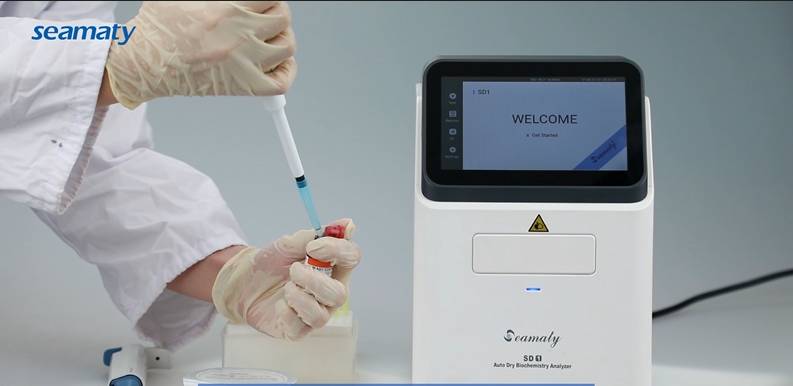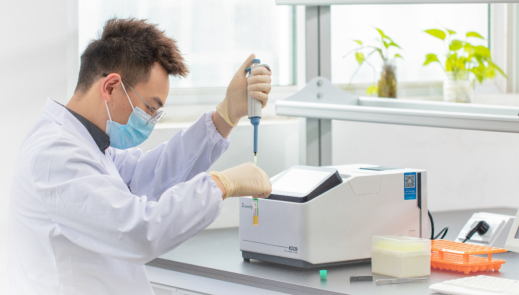What are the commonly used anticoagulants for biochemical tests?
In
biochemical tests, anticoagulants can be selected to inhibit certain clotting factors in the blood and prevent blood from clotting. In whole blood or plasma tests, a different anticoagulant is usually needed to keep the collected venous blood from coagulating. The general requirements for anticoagulants are low dosage, high solubility, and no interference with the assay. The following anticoagulants are commonly used in biochemical tests.
1. Heparin
Heparin is widely present in the liver, lung and other human tissues, is a physiological anticoagulant. Its anticoagulation mechanism is mainly to strengthen the activity of antithrombin III (AT-III), inactivate serine protease and prevent platelet aggregation, thus playing an anticoagulant role. Heparin anticoagulation is not suitable for coagulation testing, commonly used in blood gas analysis and the determination of some biochemical items, using 1.0g/ L of heparin solution 0.5ml can anticoagulate 5ml of blood.
2. Potassium oxalate
Oxalic acid root can generate calcium oxalate precipitation with calcium ions in blood, thus preventing blood coagulation. Potassium oxalate is highly soluble and has a strong anticoagulant effect. It is commonly used in the determination of urea, creatinine, fibrinogen, etc. It cannot be used in the determination of potassium and calcium.
3. Ethylenediaminetetraacetate (EDTA)
The mechanism of ethylenediaminetetraacetate (EDTA) is to prevent blood coagulation by forming a stable chelate with calcium ions in the aqueous phase. Such as EDTA-2K, etc. EDTA-2K can maintain the morphology of blood cells, platelets, etc., so it is widely used in routine blood testing, but not for the determination of calcium, sodium, and enzyme activity.
4. Sodium fluoride
Sodium fluoride-sodium oxalate mixed anticoagulant is commonly used as anticoagulant for blood glucose determination, and sodium fluoride can inhibit enolase. It can avoid the action of blood cell glucolytic enzymes and prolong the preservation time of specimens. In the presence of sodium fluoride, blood glucose concentration can be stable for 24 hours at 25°C and 48 hours at 4°C. Therefore, potassium oxalate-sodium fluoride is a frequently used anticoagulant for glucose determination specimens.
5. Citrate
The anticoagulant mechanism of citrate is that citrate forms soluble chelates with calcium ions in blood, thus preventing blood clotting. Such as sodium citrate. Commonly used in coagulation-related assays.
The above briefly introduces the anticoagulation principle of anticoagulants commonly used in clinical practice and their effects on various biochemical items. Understanding this principle can improve the accuracy of test results for various biochemical items, reduce the waste of medical resources, and thus better serve patients.
The effect of EDTA anticoagulant on biochemical tests
What is EDTA?
Ethylenediaminetetraacetic acid (EDTA) is an anticoagulant commonly used in testing, and there are three types of anticoagulants: disodium (EDTA-Na2), dipotassium (EDTA-K2) and tri-potassium salt (EDTA-K3).
Because the potassium salt is more soluble than the sodium salt, EDTA-K2 and EDTA-K3 are chosen over EDTA-Na2; and because the pH of EDTA-K2 is lower compared to EDTA-K3, which can compensate for the cellular crinkling caused by osmotic pressure, EDTA-K2 stands out as the most commonly used EDTA anticoagulant in clinical practice, with a purple cap to mark the anticoagulation tube.
Anticoagulation mechanism of EDTA
Ca2+ is an indispensable factor for both internal and external coagulation pathways. EDTA acts as an anticoagulant by forming a stable chelate with Ca2+ in the blood.
Effect of EDTA-K2 on biochemical items
Identify the items affected
Clinically, in the presence of high potassium, low calcium and low ALP, first consider.
① the case of using the wrong blood collection tube: EDTA-K2 anticoagulation tubes were used to collect blood for biochemical tests. If the blood collection tube is correct, also be alert to the following errors.
② blood collection sequence is not standardized resulting in EDTA interference: first use EDTA tube blood collection for routine blood testing, resulting in blood collection needle carrying a small amount of EDTA anticoagulant or even EDTA anticoagulant blood backflow along the blood collection needle, which in turn contaminates the next tube biochemical tube.
Items that may be affected
Through controlled trials and statistical analysis, different literature describes the biochemical items that EDTA-K2 may affect
-
liver function: AST, ALT, TP, TBIL, DBIL
-
renal function: BUN, UA
-
lipids: CHOL, HDL-C, LDL-C
-
cardiac enzymes: LDH, CK
-
other: HCO3-, AMY
Possible reasons for the effect
① EDTA chelates divalent metal ions which may act as cofactors (activators or stabilizers) for some enzymes. The change in the state of presence of these ions makes the enzyme activity change.
②EDTA has osmotic and diluting effects, which may interfere with the accuracy of biochemical assays.
Although, there is no accepted definitive evidence for the effect of EDTA on biochemical indicators other than ions and ALP, the use of lithium heparin anticoagulation tubes to collect blood samples for biochemical assays is recommended to eliminate this uncertain pre-analytical influence.



